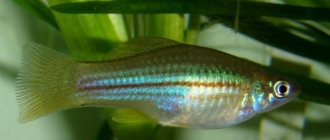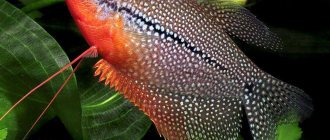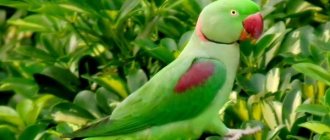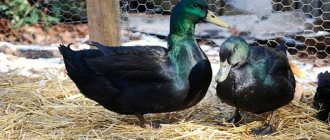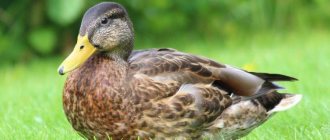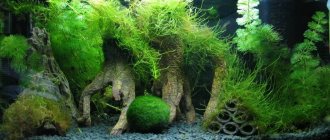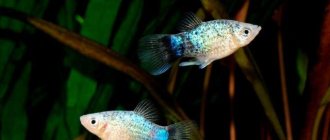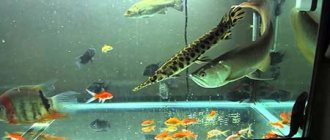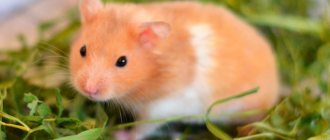The swordtail is a well-known and popular fish. The fame and popularity of swordtails can be compared, perhaps, only with guppy fish, and if you make a ranking of the popularity of aquarium fish, then the swordtail fish will most likely be in second place after guppies.
I have already mentioned earlier that the fame and popularity of aquarium fish is directly related to their ease of keeping and breeding; after all, you can’t compare, for example, handsome discus fish with swordtails or guppies, but in the popularity ranking the guppy takes the palm because discus fish are easier to keep than guppies. breeding is not at all easy. So why are guppies more popular than swordtails? Yes, because swordtails are somewhat inferior to guppy fish in keeping and breeding.
Swordtail fish are more demanding in terms of keeping conditions and are more susceptible to diseases, and the fry of guppies can grow in thickets of plants on their own and even in a general aquarium, but swordtail fry need to be kept in a separate aquarium and fed with better quality food.
But just like guppies, swordtail fish are quite simple to keep and breed; they are popular and are often found in the aquariums of both beginners and experienced aquarists.
Description
Dear readers! First of all, I would like to present to your attention material from Wikipedia where, in my opinion, it is necessary to make small but very important amendments.
The (green) swordtail (Geller's swordtail, lat. Xiphophorus hellerii) is a species of viviparous ray-finned fish of the poeciliaceae family.
The green swordtail (Xiphophorus helleri) lives in the wild, which under artificial conditions easily crosses with another species of the same genus - the common platie (Xiphophorus maculatus). The resulting hybrid forms: black, red, lemon, red-speckled are also called swordtails.
When the aquarium is overpopulated with females, swordtails change sex. Females grow a conical “sword” of the caudal fin and a genital organ. The offspring of a female + former female pair consists of almost 80-90% females.
Note: I have observed sex changes in swordtails several times. I cannot say that females change sex due to the small number of males, since according to my observations, sex change always occurred when there were a sufficient number of males. I also want to note that the males obtained from females are larger than ordinary males: they are passive, clumsy, and do not fertilize females and leave no offspring.
Wild forms: body length of males is up to 8 cm, females - up to 12 cm. In males, the lower part of the caudal fin forms a peculiar outgrowth - a sword (hence the name); coloring: on a grayish-olive background there is a longitudinal red stripe and several more reddish stripes in parallel. Females are paler. The male has a gonopodium - an anal fin transformed into a sexual organ.
Hybrid forms: can be black, red, lemon, and other colors. Males and females are not very different; they are the same in color. The male can be distinguished by the sword at the bottom of the tail and the gonopodium.
Representatives of the genus Xiphophorus inhabit the water bodies of Central America, mainly in the areas of Mexico, Guatemala, and Honduras adjacent to the Atlantic coast. They are found both in mountain rivers with rapid currents and in their lower reaches, as well as in lakes, swamps, and lagoons.
Conditions of detention:
Water temperature: 22-26 °C. Tolerates temperatures down to 15 °C well.
Water hardness: 8–25 °dH
Water acidity: pH 7-8
Note: a water temperature of 22° degrees for keeping swordtails is considered unacceptably low and will cause ichthyophthyriasis in them, and a decrease to 15° will completely kill the fish.
Food: live (tubifex, bloodworms, coretra, daphnia, cyclops), flakes, canned. It tolerates long intervals between feedings, especially if there are live plants in the aquarium, as it can feed on various algae that grow on the leaves of higher plants and the walls of the aquarium.
Note: algal fouling is another source of food for fish of the poeciliaceae family. If necessary, fish: Swordtails, Guppies and Mollies can feed on fouling of brown and green algae, thereby compensating for the lack of food or plant food.
Sex differences
It is extremely easy to distinguish males from females in swordtails. Only the male has a sword on the caudal fin, the long outgrowth from which the fish got its name.
Also, in all viviparous animals, the anal fin of the male is pointed and narrow (gonopodium), and the anal fin of the female is wide.
Quite often it happens that a female swordtail suddenly grows a sword and becomes a male! At the same time, she behaves like a male, cares for other females, but is infertile.
The reasons for this phenomenon are not completely clear.
Capacity and shape of the aquarium
It is possible to keep swordtails in a small aquarium (from 30 liters), be sure to take into account the number of fish based on the recommended standards, where there should be 1 liter per 1 cm of fish length. water. To create and maintain a complete habitat in an aquarium, the presence of soil, plants, as well as aeration and water filtration are required.
When choosing the capacity and shape of an aquarium, you need to know that male swordtails are not friendly towards each other and, given this, it is advisable to choose an aquarium that is more spacious and elongated.
Price
The price of Kohaku koi fish varies depending on their age and gender. On average, a small koi costs 50 rubles, a young one costs from 100 to 150 rubles, and an adult fish costs 200 rubles. The more contrasting and symmetrical the color of an individual, the more expensive it is. Purebred swordtails are the most valuable.
On average, an adult fish costs 200 rubles
Koi Kohaku stand out among other aquarium inhabitants due to their bright, contrasting color. Beginners are encouraged to breed them by the fact that keeping them is not difficult, and this fish is inexpensive.
Is Santa Claus the swordtail already living in your aquarium?
Water temperature
Swordtail fish are very sensitive to temperature changes and a sharp shift in temperature downward can cause the disease ichthyophthyriosis in fish. The initial sign of the disease is compression of the fins and scratching of the fish on the ground. For the comfortable health of fish, it is advisable to maintain the lower temperature limit at 26°C. To avoid temperature changes, and especially in autumn and spring, when central heating is turned off in the aquarium, it is necessary to install a heater with a built-in thermostat in the aquarium.
Feeding
Proper feeding of swordtails is not only health, but also the key to success in their breeding. Adult swordtails raised on live food are characterized by good health. Such fish do not get sick; they are always cheerful and active. Fish raised on live food can feed on various foods of artificial origin for a long time, as well as dry food: gammarus, daphnia food.
I feed my fish minced beef heart or just a scraper from a knife. But keeping fish for a long time without live food can lead to their exhaustion. Therefore, to maintain health, they need to be fed with a live lump at least occasionally. The following are very suitable live food for swordtail fish: small bloodworms, coretra, tubifex and daphnia.
It is not always possible to obtain such food, so many experienced aquarists breed live food on their own. I feed my fish with Daphnia moina. I breed Daphnia at home. Fish really like Daphnia, and they eat it willingly.
What to feed
Swordtails need a variety of food to stay healthy. This can be various dry food, frozen daphnia, bloodworms. Fish love nettle leaves, lettuce, and spinach scalded with boiling water. To get protein into the body, you can feed it with boiled egg yolk.
Note! The fish is voracious and will eat anything that is edible. Therefore, when feeding, do not give too much food. It is better to underfeed the fish than to overfeed it. Once a week, give the fish a fasting day.
Herbal supplements
As a herbal supplement, you can feed swordtails: white bread crumb and semolina. It’s not at all difficult to prepare such a simple additive: just rinse the bread crumb well in a net under the tap and only then feed it to the fish. Semolina must be steamed first.
This is done like this: pour half a teaspoon of semolina into a glass, mug, etc., then pour boiling water over it, stirring, and let stand for 15-20 minutes. Then you need to drain the cloudy water and add fresh water. Repeat the procedure until the water becomes completely clear.
Diseases
Most aquarium fish diseases are caused by improper maintenance. Frozen swordtails that have never seen live food tend to be stunted. Their behavior is sluggish; they become more and more secluded; they rarely swim to the feeder and eat poorly. The most common disease among swordtails is ichthyophthyriosis.
The causative agent of the disease is a ciliate that parasitizes the body of fish, but it usually affects only fish with a weakened immune system. The first signs of the disease: compression of the fins and scratching of the fish on the ground, as well as the appearance of a white coating in the form of white dots (semolina) on the body and fins. Sick fish completely refuse food, quickly become exhausted and eventually die.
Swordtail fish - species
In fact, Swordtails can be divided into two types - natural and aquarium.
The aquarium species has many varieties bred by breeders. The names of those bred by selection are associated, first of all, with the peculiarities of coloration, size and shape of the fins.
The natural species of Swordtails is classified by experts more definitely and has about a dozen varieties. All of them have a predominant greenish color and, as a rule, are not kept in home aquariums.
Treatment
Treatment is carried out using salt baths, as well as medications. Treatment can be carried out both in a general and separate aquarium. The first option can only be used if all the fish in the aquarium are infected. Its disadvantage is that the use of drugs such as rivanol, bicillin, etc. can destroy delicate plant species.
The second option, where treatment is carried out in a separate aquarium, is more preferable. As a rule, separate aquariums for quarantine and treatment of fish have a relatively small capacity and, if necessary, you can easily and quickly change the water in them. According to my observations, treating fish using salt baths is ineffective.
But with treatment using the drug bicillin 5, I really managed to save a lot of fish.
Treatment is carried out as follows: the drug bicillin 5 is dissolved in warm water and added in the following ratios: in a general aquarium, 500,000 units per 100 liters, six times, every other day. In a separate vessel, 1,500,000 units per 10 liters, 30 minutes, six times, every other day. The water temperature during treatment should be raised to 27-28° C.
Also, during treatment, it is necessary to monitor the fish and, if they begin to experience discomfort, which most likely indicates an overdose, it is necessary to urgently replace part of the water with fresh water, otherwise the fish will die. Read more about diseases and treatment of fish in the section: “Diseases of aquarium fish.”
Otsadnik
If you use a dark trap for childbirth, in this case you need to open it for a while every day to feed the female, and if necessary, change the water. Eventually one day you will open the hatchery and see a bunch of fry in there. Hurry to return the female to the general aquarium, and carefully transfer the fry to the nursery aquarium.
Previously, I used an ordinary three-liter jar as a depositor. He did it this way: he filled the jar with water from the same aquarium where the pregnant female was located, then he caught the female, put it in the jar and covered it with a jacket or a black plastic bag in order to create darkness in the jar so that the female would not see and eat the fry.
The disadvantage of such a fish tank is that after birth it is difficult to catch the female and fry from the jar and you have to carefully pour the contents of the jar into a basin so as not to injure the fry, and then start catching. It is much easier and more convenient to use a plastic tank with a lid.
After giving birth, you can catch the female with a net and then carefully catch the fry, for example, with a spoon or carefully pour them into a nursery aquarium.
Number of fry
The number of fry among swordtails varies. For example, I once had swordtails that brought more than a hundred fry. To date, only two females have given birth in my aquarium, and each produces just over thirty fry.
The color variation of the fry born is different and from red parents the following are born: green, lemon and red fry.
Food for fry
Starter food for fry is like milk for babies, and this food should be the healthiest and most nutritious. The ideal starter food consists of living organisms: ciliates, rotifers, cyclops and daphnia. And the general understanding of the entire listed composition is referred to as “living dust.”
There is no need to look for all the listed feed compositions for your fry. Suitable starter food for swordtail fry are: nematode worms, or even better, daphnia moina. Both types of food are easy to raise at home, and fry of fish from the poeciliaceae family grow very quickly on them.
General information
The Santa Claus swordtail (Koi Kohaku) belongs to the poeciliid fish family. This is a color morph created by hybridizing Heller's Swordtail (green) with Plaecies. Xiphophorus helleri – translated from Greek “xiphos” – sword, “phoros” – to carry. The prefix “Helleri” was given to swordtails from the name of the German naturalist Karl Bartholomeus Heller, who was the first to catch these fish in Mexican lakes and bring them to Europe.
The Santa Claus swordtail (Koi Kohaku) belongs to the poeciliid fish family.
Alternating red (or bright orange) and white stripes in color are the main feature of the breed, which makes the swordtail similar to the koi carp popular in Asian countries. For aquarists in Western countries, this coloration resembled Santa Claus's fur coat, hence the name of this swordtail.
Food for juveniles
Growing fry should be gradually accustomed to artificial feed. In my example, I use daphnia, which I breed at home, to raise fry. I begin to accustom the juveniles to artificial food in the second month by adding artificial additives to the diet, for example, minced beef heart or various dry foods: daphnia, gammarus food.
And I do it this way: before giving the waiting fish their usual food, I first add a small amount of minced beef and after 15-20 minutes I give them the live food they are accustomed to. A complete transition to another food will be indicated by the fish being full, which can be easily determined by eating, as well as by the fish’s full bellies.
Why don't they grow?
Many aquarists purchase juveniles that subsequently do not grow at all. There are several factors that negatively affect the development of fish:
- small volume of the aquarium (it should be at least 35 liters for one individual);
- poor care, infrequent water changes, which results in the formation of a lot of ammonia;
- The diet does not include plant foods.
Such situations should be corrected immediately. If a little time has passed, then Swordtails can still grow, sometimes they remain small.
Transfer to a community aquarium
Young fish that have grown well and are accustomed to artificial food should be transplanted into a community aquarium. The approximate size of such fish can be 2-2.5 cm, and the laggards need to remain in the nursery aquarium to grow up. But in the end, everything will depend on what kind of neighbors await them in the common aquarium.
For example, if they turn out to be large angelfish, golden or Sumatran barbs, do not rush so as not to be eaten by stupid teenagers. Never introduce all fish into a common aquarium at once. If a chase starts, you won't have time to return all the fish safe and sound. For the test, you need to launch only 2-3 fish and, if no one offends them, you can launch the rest. Well, that's probably all. I wish you all success in breeding swordtails!
Compatibility
Swordtails are quite peaceful and get along without problems in common aquariums. But the male can become a local “bully”. Most often this is caused by incorrect selection of the sex and age composition of the inhabitants of the aquarium. The best option is to keep one male swordtail with several females. If there are several males, then the number of females should significantly predominate in order to disperse the attention and aggression of the males. It is also necessary to ensure that the aquarium is large enough so that the swordtails do not bump into each other at every step.
Almost all peace-loving fish can become neighbors of swordtails. The proximity to platies and mollies will be favorable; peaceful cichlids (for example, angelfish), tetras, minors, zebrafish and barbs, and popular species of catfish (corydoras, ancistrus, thoracatum) will also be suitable.
An unfavorable neighborhood is with large, aggressive cichlids: acara, astronotus, cichlids, and proximity to fish with lush, veiled tails (fins), for example, with cockerels, goldfish, since swordtails are quite capable of biting them.
